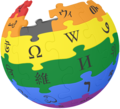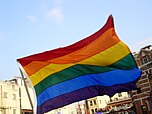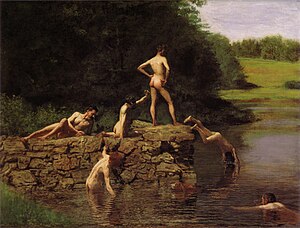Portal:LGBT
| Main page | WikiProjects & Things you can do |

|
The LGBTQ+ Portal |

|

|

|
Introduction LGBT is an initialism that stands for "lesbian, gay, bisexual, and transgender". It may refer to anyone who is non-heterosexual, non-heteroromantic, or non-cisgender, instead of exclusively to people who are lesbian, gay, bisexual, or transgender. A variant, LGBTQ, adds the letter Q for those who identify as queer (which can be synonymous with LGBT) or are questioning their sexual or gender identity. Another variation, LGBTQ+, adds a plus sign "represents those who are part of the community, but for whom LGBTQ does not accurately capture or reflect their identity". Many further variations of the acronym exist, such as LGBT+ (simplified to encompass the Q concept within the plus sign), LGBTQIA+ (adding intersex, asexual, aromantic and agender), and 2SLGBTQ+ (adding two-spirit for a term specific to Indigenous North Americans). The LGBT label is not universally agreed to by everyone that it is generally intended to include. The variations GLBT and GLBTQ rearrange the letters in the acronym. In use since the late 1980s, the initialism, as well as some of its common variants, functions as an umbrella term for marginalized sexualities and gender identities. LGBT is an adaptation of LGB, which in the mid-to-late 1980s began to replace the term gay (or gay and lesbian) in reference to the broader LGBT community. When not inclusive of transgender people, the shorter LGB is still used. (Full article...) Selected article -The White Night riots were a series of violent events sparked by an announcement of a lenient sentencing of Dan White for the assassinations of George Moscone, the mayor of San Francisco, and of Harvey Milk, a member of the city's Board of Supervisors who was one of the first openly gay elected officials in the United States. The events took place on the night of May 21, 1979, in San Francisco. Earlier that day White had been convicted of voluntary manslaughter, the lightest possible conviction for his actions. The lesser conviction outraged the city's gay community, setting off the most violent reaction by gay Americans since the 1969 Stonewall riots in New York City. The gay community of San Francisco had a longstanding conflict with the San Francisco Police Department. White's status as a former police officer intensified the community's anger at the SFPD. Initial demonstrations took place as a peaceful march through the Castro district of San Francisco. After the crowd arrived at the San Francisco City Hall, violence began. The events caused hundreds of thousands of dollars worth of property damage to City Hall and the surrounding area, as well as injuries to police officers and rioters. (Full article...)Selected biography -Romaine Brooks (born Beatrice Romaine Goddard; May 1, 1874 – December 7, 1970) was an American painter who worked mostly in Paris and Capri. She specialized in portraiture and used a subdued tonal palette keyed to the color gray. Brooks ignored contemporary artistic trends such as Cubism and Fauvism, drawing on her own original aesthetic inspired by the works of Charles Conder, Walter Sickert, and James McNeill Whistler. Her subjects ranged from anonymous models to titled aristocrats. She is best known for her images of women in androgynous or masculine dress, including her self-portrait of 1923, which is her most widely reproduced work. Although her family was wealthy, Brooks had an unhappy childhood after her alcoholic father abandoned the family; her mother was emotionally abusive and her brother mentally ill. By her own account, her childhood cast a shadow over her whole life. She spent several years in Italy and France as a poor art student, then inherited a fortune upon her mother's death in 1902. Wealth gave her the freedom to choose her own subjects. She often painted people close to her, such as the Italian writer and politician Gabriele D'Annunzio, the Russian dancer Ida Rubinstein, and her partner of more than 50 years, the writer Natalie Barney. (Full article...)Selected quote -
Current events
Selected image - The Swimming Hole (1884–85) is a painting by Thomas Eakins. It is perhaps the most famous work by Eakins and considered a masterpiece of American painting. In this work, Eakins took advantage of an exception to the generally prudish Victorian attitude to nudity: swimming naked was widely accepted, and for males was seen as normal, even in public spaces. Eakins was the first American artist to portray swimming in the nude. By the 1970s some American writers were beginning to see Eakins' work, and specifically The Swimming Hole, as having homoerotic overtones. However, Eakins' (homo-)sexuality has never been conclusively determined.
Did you know… -
This month's birthdays
Selected lists
Related portalsFeatured contentThe following articles and lists have been identified as some of the best produced by the Wikipedia community:
TopicsCategoriesAssociated WikimediaThe following Wikimedia Foundation sister projects provide more on this subject:
Discover Wikipedia using portals |

























